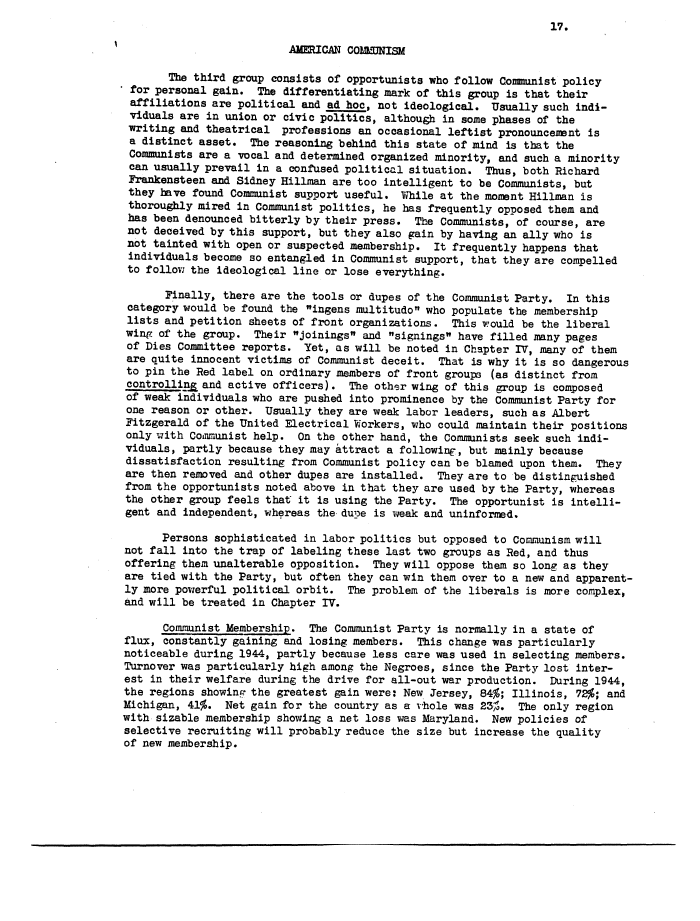 |
||||
 |
||||
| 17. AMERICAN COiaiDNISM The third group consists of opportunists who follow Communist policy for personal gain. The differentiating mark of this group is that their affiliations are political and ad hoc, not ideological. Usually such indi- viduals are in union or civic politics, although in some phases of the writing and theatrical professions an occasional leftist pronouncenBnt is a distinct asset. The reasoning behind this state of mind is that the Communists are a vocal and determined organized minority, and such a minority can usually prevail in a confused political situation. Thus, both Richard Frankensteen and Sidney Hillman are too intelligent to be Communists, but they have found Communist support useful. While at the moment Hillman is thoroughly mired in Communist politics, he has frequently opposed them and has been denounced bitterly by their press. The Communists/of course, are not deceived by this support, but they also gain by having an ally who is not tainted with open or suspected membership. It frequently happens that individuals become so entangled in Communist support, that they are compelled to follow the ideological line or lose everything. Finally, there are the tools or dupes of the Communist Party. In this category would be found the ningens multitude" who populate the membership lists and petition sheets of front organizations. This v/ould be the liberal wing of the group. Their "joinings" and "signings" have filled many pages of Dies Committee reports. Yet, as will be noted in Chapter IV, many of them are quite innocent victims of Communist deceit. That is why it is so dangerous to pin the Red label on ordinary members of front groups (as distinct from controlling and active officers). The other wing of this group is composed of weak individuals who are pushed into prominence by the Communist Party for one reason or other. Usually they are weak labor leaders, such as Albert Fitzgerald of the United Electrical Workers, who could maintain their positions only with Communist help. On the other hand, the Communists seek such indi- viduals, partly because they may attract a following, but mainly because dissatisfaction resulting from Communist policy can be blamed upon them. They are then removed and other dupes are installed. They are to be distinguished from the opportunists noted above in that they are used by the Party, whereas the other group feels that" it is using the Party. The opportunist is intelli- gent and independent, whereas the dupe is weak and uninformed. Persons sophisticated in labor politics but opposed to Communism will not fall into the trap of labeling these last two groups as Red, and thus offering them unalterable opposition. They will oppose them so long as they are tied with the Party, but often they can win them over to a new and apparent- ly more powerful political orbit. The problem of the liberals is more complex, and will be treated in Chapter IV. Communist Membership. The Communist Party is normally in a state of flux, constantly gaining and losing members. This change was particularly noticeable during 1944, partly because less care was used in selecting members. Turnover was particularly high among the Negroes, since the Party lost inter- est in their welfare during the drive for all-out war production. Daring 1944, the regions showing- the greatest gain were: New Jersey, 84$; Illinois, 72$; and Michigan, 41$. Net gain for the country as a rhole was 23^. The only region with sizable membership showing a net loss was Maryland. New policies of selective recruiting will probably reduce the size but increase the quality of new membership. |